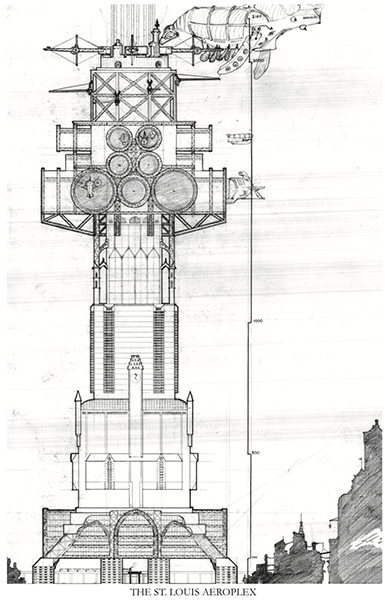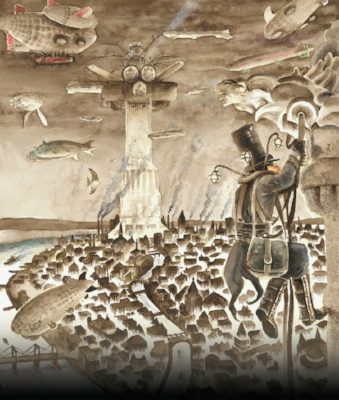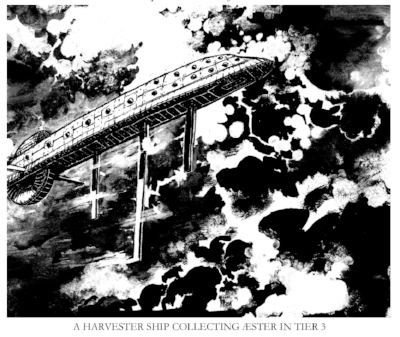To understand the nuts and bolts of how the æsterverse and the technology within it works, there are some core pieces that need to be explained. I’ll try to not sound like that high school teacher you had who could put a monk to sleep at thirty paces just by opening his mouth, but this post is about tech, so I’m going to get a bit, well – technical. And as I’ve said before, this is just an overview, I’m barely going to scratch the surface of what’s out there, but this should give you a better idea of how the world works, why, and some of its thematic elements.

One of the first keys to getting your head around all of this is to understand where everything started from. 1862 is the accepted date for the beginning of the Rise. Some of the greatest minds in human history were living at that time. Others who would form the basis of scientific thought we take for granted today would be born during the twenty year period of the Rise, 1862 – 1882. The problem is that many of them simply didn’t survive. Entire schools of thought we now consider foundational never came into being because the people who pioneered them didn’t live long enough to create them. By the same token, some rose to primacy in the æsterverse who have historically taken a back seat in the real world. To say that Nikola Tesla saved the world in the æsterverse might be reaching a little, but isn’t inaccurate. The reason? The fluorescent light can be turned into a grow light – that’s it. The ability to grow plants where there is no sunlight made Telsa a hero. Every city of light in the æsterverse owes its life to Tesla. And Edison? He’s the footnote in history in the æsterverse.
Another important concept is that during the rise, technology slipped backward. If it wasn’t useful for survival – right now – it fell by the wayside. Whole schools of thought, both social and technical withered and died. The champions of those ways of thinking died, the writings were lost, or they were simply forgotten. When you lose two-thirds of the human population in twenty years, a lot falls into the cracks never to be seen again.
Science in the 1860s was observational. The idea of “theoretical science” like what Einstein did, was considered nothing but flights of fancy. In the years of brute necessity during the rise, there was no room for it. Sure, there were drawing room fantasies, but the scientific community had bigger fish to fry – how to stop the extinction of the Human Race. By the 1920s, (PAe 60’s according to the æsterverse calendar. Sixty years PAe – Post Æster) the sciences had backslid and started to rebuilt themselves in whole new ways. And there was this new stuff that was part of the equation – the Æster. As science and technology rebuilt itself in the new, darker world, æster was now inextricably tied to every school of thought. This included social and spiritual. But we’ll deal with those in another post. Let’s stick to technology here.
Technology and the Draw
The draw is the key to everything happening the the æster’s clouds. To remind you, the draw pulls things upward into the sky. At the æster floor (nominally ten thousand feet), the draw overcomes the force of gravity, so things begin to float. It holds ships and platforms aloft and makes things like the giant aeroplexes possible. The force of the draw grows stronger the higher in altitude, or “deeper” you go into the æster.
This effect is a key element to the story of my first book, “The Tomahawk Incident.” If a ship goes too deep into the æster, they may reach a point where their engines cannot overcome the power of the draw. Unable to fight the draw, the ship will be pulled upward and destroyed. To combat this, the British Admiralty created the Æster Rescue Service. The “Tomahawk Incident” is about a rescue service ship that gets pulled into a mystery and a threat that no one on the ground is aware of.

Back on topic – Technology. Aeroplexes exist to connect earth and æster. “Sky Hooks” are gigantic cable structures that run from the ground to æster anchors in the sky. Platforms above the æster floor are built onto the cables. Elevators transport everything from cargo and personnel to entire ships up and down these cables. Aeroplexes are only able to achieve their staggering heights by being built around sky hooks, or more accurately, onto them. The skyhook cables are the spine an aeroplex’s entire structure is built onto. The St. Louis aeroplex pictured above stands over twenty-one-hundred feet high. That’s more than twice the height of the Eiffel Tower to give you a sense of scale. The tallest aeroplex in the world, London, towers more than three thousand feet (more than three Eiffel Towers high) above the London city of light.
A quick note on electricity. The æster is basically like one gigantic battery with differences in potential constantly fighting for equilibrium in it’s supercharged clouds. Lightning is a constant expression of this interplay. Cities of light are powered by the æster through the basic electrical principle of electron flow. Current will flow along a conductor run from something with a charge (the æster) to ground. Power is not an issue in any city of light, nor is it a problem for most ships operating in the æster. Æsterships rectify electricity directly from the environment around them. The problem is controlling all that current. You are plugging into a battery the size of the whole northern hemisphere after all. Between insulators, bypasses, and careful regulation, ships and cities of light ride the lightning, having all the power they require with no need for any other kind of fuel. And hopefully without ending up getting burnt to a crisp. Needless to say, entire fields of scientific endeavor now study the peculiarities of the æster’s extreme current, the metallurgy of cables that carry it, the structures around it, and glass and ceramics used as insulators, just to name a few. These are just some of a cornucopia of unique fields of study that have come into being in the æsterverse.
As I said in the first Æsterverse 101 post. The draw acts like in inverse ocean, becoming stronger the higher in altitude, or deeper into the æster you go. Things “sink” upward into it. This throws normal physics on its head when it comes to things like navigation and gunnery. Imagine you are firing a gun at something in the æster. If the draw is strong enough you would have to aim beneath your target, calculating the ballistics of the shot based on the draw pulling the projectile upward. And to further complicate matters, unlike gravity, the effect of the draw changes depending on where you are in the æster. For a ship traveling in the æster, this adds an additional dimension of difficulty to every navigation problem.
To combat this problem and others unique to the cloud dynamics of the æster, beacon roads crisscross the sky to let ships know where it is safe to travel.
The sky isn’t owned by the terrestrial empires. There are “gentleman’s agreements” and a few treaties about territories in the æster, but they are difficult to enforce at best. The sky above the established boundaries of a nation or empire are considered to belong to them. But when beacon roads extend beyond those borders, who owns, maintains and ensures the safety of those critical routes gets muddy pretty quickly. Warships and pathfinder vessels called Forgers do not rely on beacon roads for navigation, but in so doing take extraordinary risks in the dangerously unpredictable skies.
Electrostatic Sheathing – As I mentioned earlier, æster is corrosive. One of the ways it is prevented from just chewing its way through the hulls of ships and platforms is through the use of electrostatic sheathing, a charged field that mitigates the corrosive elements of the æster. But those fields must be kept balanced against the constantly changing electrical potential in the æster around them. “Æster Strikes” occur when an object’s electrical signature is sufficiently out of balance with the surrounding æster that it becomes the lowest point of potential. Put simply, a ship or platform whose sheathing has become out of balance suddenly becomes the target of huge amounts of current. This usually manifests in something resembling a cataclysmic, long lasting, lightning strike. Depending on the ship, how out of balance it is with its surroundings, and the concentration of the æster around it, it can make for a rough ride, or the ship can be incinerated. Needless to say, traveling in the æster is not for the faint of heart.
Electro-Kinetic Drives – Æsterships use electro-kinetic drives to push and pull them along the electrical fields and currents in the æster’s ever-changing supercharged clouds. Similarly, platforms, beacons and all other structures use electro-kinetic motors for station-keeping and maneuvering.
What about where there isn’t Æster?
The æster only covers the higher latitudes of the northern and southern hemispheres. It grows sufficiently thin as it reaches the tropics to make it hazardous for æsterships to travel there. But people still fly.
Airships are common everywhere where there is no æster. Fast packet mail, pleasure liners and giant passenger ships crisscross the skies along the equator and operate in the boundary area below the æster floor at ten thousand feet and along the fringes where the æster is too thin for æsterships to navigate. Some are little more than motorized baloons, others are giant dirigibles.
But there is also another class of vessel out there, the Hybrid. Hybrids are vessels capable of operating in both worlds. Expensive, difficult to maintain and requiring extraordinarily skilled crews, hybrids can operate in the no-mans land where neither full æsterships, or normal airships can safely operate. Forgers, the nickname given to æster pathfinder vessels, are some of the most widely recognized hybrid ships. Their job is to map the æster, identify and establish new beacon roads and explore the wonders of the volatile skies.
But æster’s usefulness isn’t restricted to the clouds. Æster is collected and refined for fuel, used as a base component in industrial chemistry, even used in medicine. It may not be the basis of all physical sciences in the æsterverse, but it is one of the single largest contributors. Airships and hybrids depend on the Æster Lifting Component to fly. ALC is an electrically charged gas with a higher lift ratio than hydrogen or helium whose unique characteristics allow its buoyancy to be adjusted by altering its electrical charge.
Æster has been used as both a benefit and a bane in medicine. From it, vaccines have been produced that combat new diseases spawned during the rise and illnesses born from a world where mushrooms, fungi and molds have taken over the niche previously occupied by chlorophyll based life.
But it’s most infamous medical use has been the creation of the Janissary Formula. The mixture of æster, opiates and other unknown chemicals is used to create the Ottoman supersoldiers, the Janissaries. Called the “Crimson Death,” they are the most feared fighting force in the world. Stronger, faster, and able to withstand wounds that would kill normal men, the Janissary Formula makes them superhuman. Breathed from the time they are infants, they cannot survive without it for long periods of time. But it’s ability to heal them allows for the implantation of Anthromechanics, physical modifications that further increase their legendary their physical prowess. Sheathed in armor that somehow communicates with the anthromechanics in their bodies, they are relentless instruments of war.
So, there’s a quick overview of technology in the æsterverse and some hooks to things that are in my books. =) You can look forward to getting to know the captain and crew of the Æster Pathfinder Forger Achilles in “The Tomahawk Incident.”


COMMENTs:
0